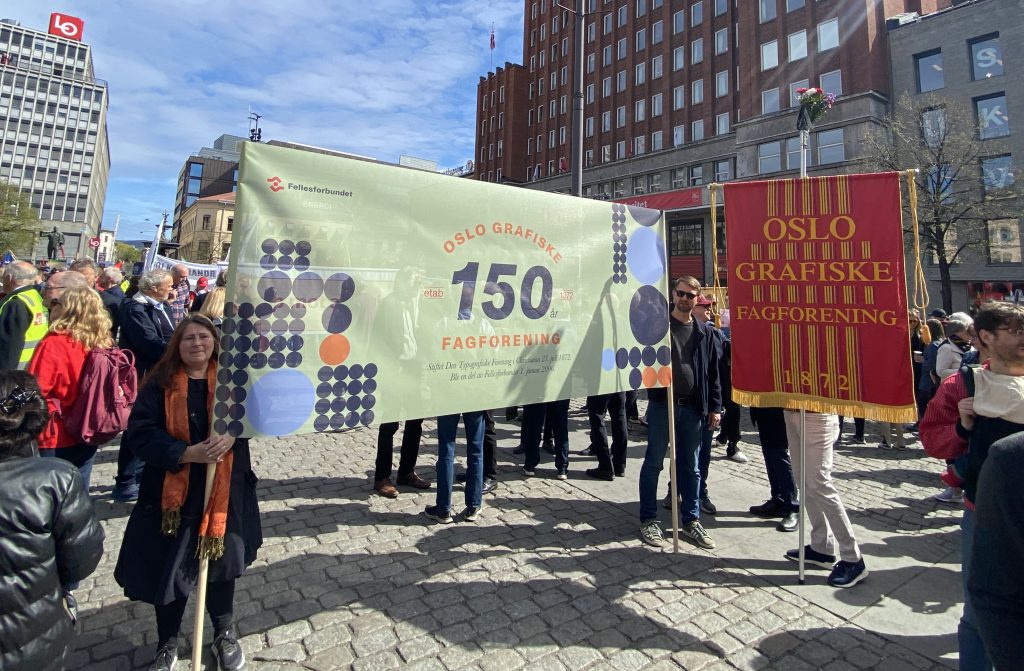Den Europeiske fagbevegelsen har fått øynene opp for arbeidet til Oslo grafiske fagforening. De ønsket å feire vårt 150-års jubileum med en artikkel om oss på sin hjemmeside. Den originale artikkelen er kopiert inn under – og finnes på UNI Europas hjemmeside og forside nå.

Vi ble invitert til å gå først i den offesielle 1. mai paraden til LO i år. Her holdes jubileumsbanneret og fanen vår av aktive medlemmer. Foto: Ina Susanne Karlsen
Original artikkel:
Oslo graphical workers look to the future on 150th anniversary of their union
As printing and graphical workers in Norway celebrate their union’s 150 years, they are turning towards the future to keep building workers’ power. We take a look at the fresh wind of ambition sweeping through Fellesforbundet’s Oslo Graphical Union, the country’s oldest union, driving improved conditions that live up to a proud organising heritage.
A sector in movement
“Labour relations in the traditional graphical sector are well established and through their union, the workers have achieved good quality conditions. The times have changed, and our union must follow, with the evolution of the graphical sector, we have gotten a new area of graphical workers who work from an office on computers rather than in larger printing presses. While traditional printing remains a core service, the graphical industry today also includes the design agencies. We are drawing on the union’s vast experience to establish good conditions in these developing sectors,” said Kristin Mulleng Sezer, President of Oslo Graphical Union.
The products of those who work in design and advertising agencies is hugely visible, but their working conditions are not. Workers in this growing graphical design sector have not yet organised to the same extent as their counterparts in the traditional graphical sector. As a result, working conditions can at times be far from enviable.
Reports of unpaid overtime, unmanageable workloads and unpredictable hours are frequent. In response, through their union, the workers decided to increase support to organising in this growing sector of employment.
Leveraging public procurement for a first breakthrough
While a lot of workers in Norway have collective bargaining protection, this is not the case for most people working in design and advertising agencies. In order to change this, the union would have to show what was possible by getting a first collective bargaining agreement within one such agency.
Workers at BØK, an Oslo-based design agency, took a pro-active approach. Establishing a unified workplace, the union’s shop steward led colleague-to-colleague exchanges. Common concerns were identified which also resulted in new members joining the union.
To establish this first collective bargaining agreement, the union’s strategy involved leveraging Norway’s public procurement law. This law requires public institutions to give preference to companies that have a collective agreement with their workers when awarding public contracts. Given that most graphical agencies are not covered, BØK are set to gain a major leg up in accessing projects for public institutions, which represent a significant client base in the sector.
The union’s approach to reaching out to management was to highlight the public contracts it could access through having a collective agreement. Not only could the company access public contracts, but a collective agreement represents a certificate of decent working conditions that could also be used when applying to projects for other socially responsible clients.
When the time was ripe to establish contact with the CEO, these arguments proved effective and the response was positive. Ten months after the launch of the organising drive, the workers at BØK had a collective agreement with their employer in February 2022.
A sector-wide strategy
“While this first breakthrough at BØK sets the tone, we will not be stopping there. Our ambition is to establish decent work across the sector. For that, we will make collective bargaining the rule, rather than the exception,” said Carsten Østby Håkonsen, Vice-President of the Oslo Graphical Union.
Poor working conditions are becoming an increasingly common talking point amongst the graphic design community. A targeted media outreach by Oslo Graphical Union, Fellesforbundet helped workers see organising as the solution. Drawing on their own experiences as workers in the sector, union representatives authored opinion pieces that they placed in specialised labour and design websites headlining the problems respectively: Large wage gaps, poor pension, no overtime pay and We recognize ourselves in crying at work, fancy dinners as a reward instead of an average salary.
The design agency sector is characterised by a larger number of small to medium-sized employers, as well as a more limited number of larger companies. The experience at BØK set a precedent, but organising company by company leaves the door open to undercutting and is resource intensive. Winning over some of the larger companies while they can still benefit from advantages of early-adopters of collective bargaining will be key to changing the tide.
Another part of the unions strategy is to sow the seed of change among students. The union is set to tour universities, vocational institutes as well as secondary schools to spread the word. By showing students that organising is the solution to addressing workplace issues, the union is providing them with the tools to improve their future conditions.
“150 years young and still going strong! The strategic thinking at Oslo Graphical Union-Fellesforbundet is a wealth to the union movement. Together we can draw on our collective heritage and keep building workers’ power now and for the next 150 years,” said Oliver Roethig, Regional Secretary of UNI Europa.
